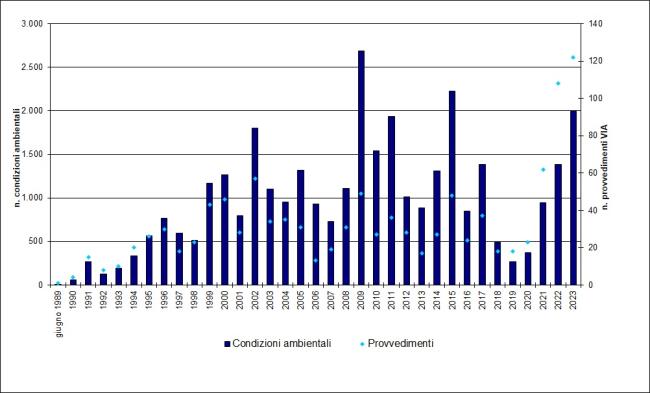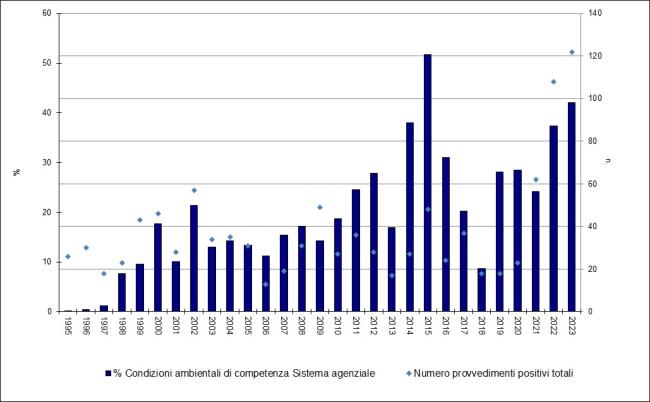Panel 1
Anna Cacciuni, Caterina D'Anna
The indicator measures the capacity to minimize the environmental impact of a project subject to an Environmental Impact Assessment (EIA) decision by imposing binding and mandatory environmental conditions during both the implementation and operation phases of the project. The indicator highlights the annual trend in both the total number and the average number (per decision) of environmental conditions contained in EIA decisions.
To determine this indicator, all environmental conditions issued by MASE, MiC, Regions and Local Authorities included in EIA decisions were analyzed, identifying those whose compliance verification is entrusted to the National Environmental Protection System (SNPA). Between June 1989 and 2023, an average of 30 environmental conditions per decision was recorded, with a minimum of 6 in 1989 and a maximum of 72 in 2006.
The indicator represents the number and categories of environmental conditions contained in EIA decisions. It shows the trend over the years in the total number of environmental conditions and the average number per decision.
To build the indicator, all environmental conditions included in EIA decisions were analyzed and counted, issued by MASE, MiC, Regions, and Local Authorities. In addition, the environmental conditions involving SNPA were identified starting from 1995 (the year of establishment of ANPA and the ARPA/APPA network – Law 01/1994).
To measure the capacity to minimize the environmental impact of the project subject to the decision, by imposing binding and mandatory conditions for the implementation and operation of the project.
- Legislative Decree 152/2006 and subsequent amendments
- Legislative Decree No. 104 of 2017
- Decree Law 34/2020, converted into Law 77/2020
- Decree Law 76/2020, converted into Law 120/2020
- Decree Law 77/2021 (Simplification Decree), converted into Law No. 108 of 29 July 2021
- Decree Law 92/2021 (Urgent measures for strengthening the Ministry for Ecological Transition and regarding sports)
Panel 2
Verification of compliance with the environmental conditions imposed through the EIA (Environmental Impact Assessment) measures.
Data quality assessment
Ministry of Environment and Energy Security (MASE)
Starting from the EIA measures, available on the MASE website (https://va.mite.gov.it/it-IT), the environmental conditions were analyzed and counted.
National
June 1989 - 2023
Indicator assessment
EIA decisions were examined, and all environmental conditions contained therein were analyzed and counted, issued by MASE, MiC, Regions, and Local Authorities. All environmental conditions involving SNPA were identified, as well as those under the responsibility of MASE.
In 2022, the average number of environmental conditions per decision was 13, while in 2023 this average rose to 16 (Table 1).
Analysis of the last two years shows an increase in both the number of decisions issued and the average number of environmental conditions per decision (Table 1 and Figure 1).
Between June 1989 and 2023, a total of 1,136 EIA decisions were issued, containing 33,917 environmental conditions, with an average of 30 conditions per decision.
The average number of conditions per decision rose from 6 in 1989 to 72 in 2006, then decreased to 13 in 2022, with a slight increase to 16 in 2023 (Table 1).
The application of EIA procedures in Italy reflects what has occurred across Europe: the regulatory system has been strengthened and completed through the transposition of EU Directives; public participation and administrative transparency have increased; and the quality of Environmental Impact Studies submitted has improved.
For these reasons, a positive trend can be identified, as the recent decrease in the average number of conditions suggests greater attention to the drafting of Environmental Impact Studies by project proponents.
Data
Table 1: Number of positive EIA decisions, number of environmental conditions, and average number of environmental conditions per decision
ISPRA processing based on MASE data
Table 2: Number and percentage of environmental conditions whose compliance verification is under the responsibility of the Environmental Agencies System (ISPRA–ARPA/APPA)
ISPRA processing based on MASE data
Figure 1: Trend in the number of environmental conditions and EIA decisions
ISPRA processing based on MASE data
Figure 2: Total number of environmental conditions in EIA decisions and conditions whose compliance verification is under the responsibility of the SNPA
ISPRA processing based on MASE data


From Figure 1, a parallel trend can be observed between the number of EIA decisions and the number of environmental conditions. Between 2022 and 2023, there was an increase in the number of EIA decisions issued and a decrease in the average number of conditions per decision. Table 2 and Figure 2 show that the environmental conditions involving SNPA in compliance verification (1995–2023) amounted to 7,302, or 22% of the total.
The percentage of environmental conditions involving SNPA rose steadily in the early years, remained fairly constant between 2003 and 2009, and increased significantly between 2010 and 2015, reflecting the consolidation of SNPA’s role in environmental monitoring and control. In more recent years, the percentage has declined.
In 2022, 108 positive EIA decisions were issued, with a total of 1,385 environmental conditions, 517 (37%) of which were attributed to SNPA. In 2023, 122 positive EIA decisions were issued, with a total of 1,999 environmental conditions, 841 (42%) of which were attributed to SNPA.